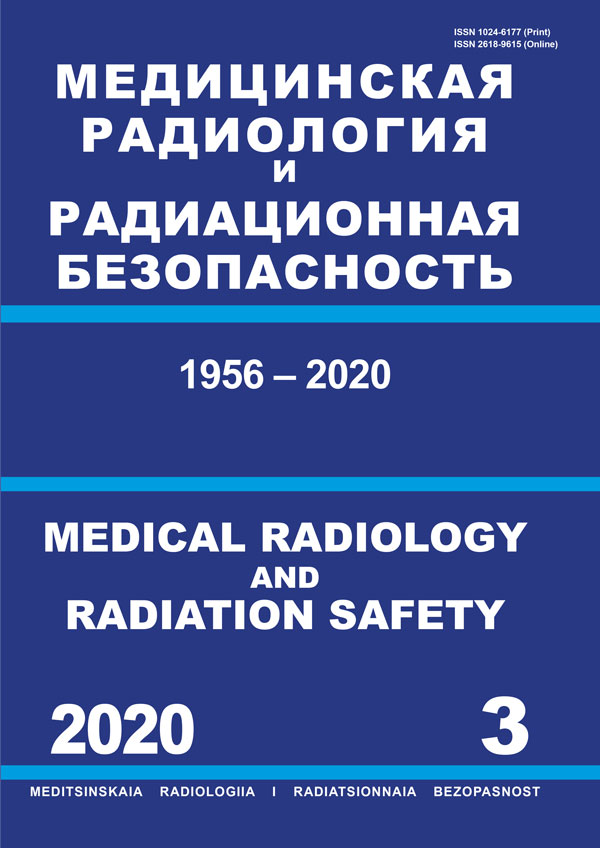Russian Federation
UDC 61
CSCSTI 86.25
Russian Classification of Professions by Education 30.05.02
Russian Library and Bibliographic Classification 51
Russian Trade and Bibliographic Classification 5708
Russian Trade and Bibliographic Classification 6464
BISAC HEA021000 Safety
BISAC MED080000 Radiology, Radiotherapy & Nuclear Medicine
BISAC SCI058000 Radiation
Purpose: Carry out a comparative analysis of the criteria and practices of conduct Iodine thyroid blocking (ITB) in various countries from the standpoint of WHO publication (2017) “Iodine thyroid blocking. Guidelines for use in planning for and responding to radiological and nuclear emergencies” (WHO Guidelines) and national Rules and requirements 2.6.1.2523-09 (NRB-99/2009) and other documents, including facility and territorial Emergency plans and instructions contained therein. Results: The WHO Guidelines, prepared using the GRADE method, determine the conditional recommendation in favor of conduct ITB in the event of a release of radioactive iodine: “During a radiation or nuclear emergency, the provision of ITB for people who are at risk of exposure to radioactive iodine should be implemented as urgent protective action as part of a justified and optimized protection strategy”. In the WHO Guidelines, such a recommendation is recognized as qualitatively low, and the strength of this recommendation is conditional, due to insufficient data on the use of stable iodine drugs. However, after studying the implementation of this protective measure, it was determined that the benefits of the intervention outweigh the disadvantages and associated costs. The article contains a selective discussion and opinion of the authors on a number of key issues of organization and conduct ITB. Conclusion: A comparative analysis revealed the similarities and differences between foreign and national practices of conduct ITB. The convergence of positions is necessary and aimed at harmonizing national and international criteria and practices. To date, there is no federal level document in the Russian regulatory framework that regulates the planning, organization and conduct of ITB in relation to people who are not associated with work at radiation hazardous facilities and do not live on territories served by the FMBA of Russia. Based on this, a range of priority important issues that need to be addressed has been identified.
radiation safety, emergency preparedness, emergency medical response, iodine thyroid blocking, radiation accident, dose criteria
1. World Health Organization. Iodine thyroid blocking. Guidelines for use in planning for and responding to radiological and nuclear emergencies. Geneva: WHO. 2017. 46 p.
2. Aleksakhin RM, Buldakov LA, Gubanov VA, et al. Major Radiation Accidents: Consequences and Protective Measures. Ilyin LA, Gubanov VA, eds. Moscow: IzdAT. 2001. 752 p. (In Russ.).
3. Savitsky VL, Pechiborshch VP, Ivanko OM, at al. Problems of organizing iodine prophylaxis in Ukraine in emergency situations. Emergency Medicine. 2014;(3):21-7. (In Russ.).
4. United Nations Scientific Committee on the Effects of Atomic Radiation. Health effects due to radiation from the Chernobyl accident. Scientific application D to the UNSCEAR 2008 Report to the General Assembly. New York: UN.2012. 173 p. (In Russ.).
5. Gerasimov GA, Figge D. Chernobyl: twenty years later. Clinical and Experimental Thyroidology. 2006;2(2):5-14. (In Russ.).
6. Hirose K. The Accident at TEPCO’s Fukushima Nuclear Power Stations (Nuclear Emergency Response Headquarters, Government of Japan). Vienna: IAEA. 2011.
7. Radiation Safety Standards (RSS-99/2009). Sanitary rules and regulations SanPiN 2.6.1.2523-09. Moscow. 2009. 100 p. (In Russ.).
8. Sanitary rules for the design and operation of nuclear power plants. Sanitary rules and regulations SanPiN 2.6.1.24-03. Moscow. 2004. 66 p. (In Russ.).
9. Application, storage and updating of the kit of individual medical civil protection «First Aid Kit» for the prevention of radiation injuries of workers (personnel) of organizations and personnel of civil defense forces. Recommendations of FMBA of Russia 17.39-17-2017. Moscow. 2017. (In Russ.).
10. On approval of the requirements for completing with medicines and medical products a set of individual medical civil protection for primary health care and first aid: Ministry of Health of Russia Order at 02.15.2013 №70n. Available at: https://www.rosminzdrav.ru/documents/5457-prikaz-minzdrava-rossii-ot-15-fevralya-2013-g-n-70n (In Russ.).
11. Guidelines for stable iodine prophylaxis in the event of a radiation accident. Guidelines. Group Requirements for life support systems in extreme situations and special systems. M. 2010. 44 p. (In Russ.).
12. Preparedness and Response for a Nuclear or Radiological Emergency. General Safety Requirements No. GSR Part 7. Vienna: IAEA. 2015. 102 pp.
13. Criteria for Use in Preparedness and Response for Nuclear or Radiological Emergency. IAEA Safety Standards Series No. GSG-2. Vienna: IAEA. 2011.
14. The Grading of Recommendations Assessment, Development and Evaluation (short GRADE). Available at: http://www.gradeworkinggroup.org (Accessed 29.01.2020). (In Russ.).
15. Sanitary norms and rules “Requirements for radiation safety” and the Hygienic standard “Criteria for assessing radiation exposure”. Approved by resolution of the Ministry of Health of the Republic of Belarus 28.12.2012. No. 213. (In Russ.).
16. Medical effectiveness of iodine prophylaxis in a nuclear reactor emergency situation and overview of European practices. Final Report of Contract TREN/08/NUCL/SI2.520028. European Commission Radiation Protection #165. 2010.
17. Guidelines for iodine prophylaxis as a protective measure: information for physicians. Japan Med Association J. 2014;57(3):113-23. Available at: https://www.ncbi.nlm.nih.gov/pmc/articles/PMC4356652/ (Accessed 02.02.2020).
18. U.S. Department of Health and Human Services Food and Drug Administration Center for Drug Evaluation and Research (CDER). Guidance Potassium Iodide as a Thyroid Blocking Agent in Radiation Emergencies. 2001.
19. National Radiological Protection Board (NRPB). Stable Iodine Prophylaxis. Recommendations of the 2nd UK Working Group on Stable Iodine Prophylaxis. Vol.12. № 3. 2001.
20. Galushkin BA, Bogdanova LC. Decision Making on Measures to Protect Population in Case of Radiological Accident. Civil Security Technology. 2019;60(2):80-8. (In Russ.).
21. Avetisov GM, Goncharov SF. Problems of Assured Preparedness for Iodine Prophylaxis of Population in case of Large-Scale Nuclear Accident. Disaster Medicine 2014;86(2)8-6. (In Russ.).





